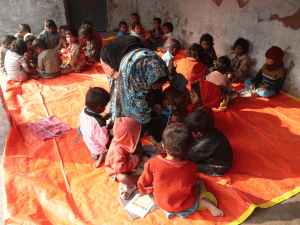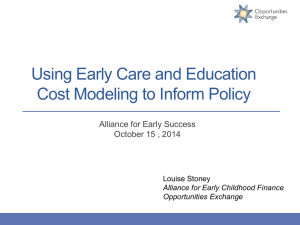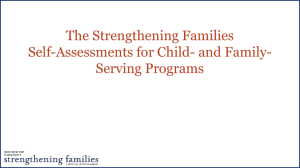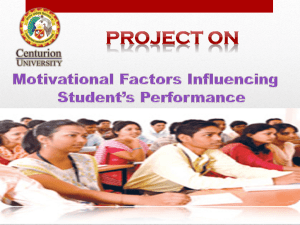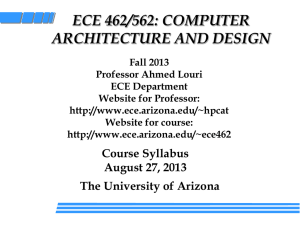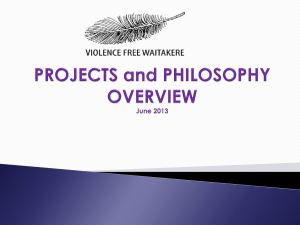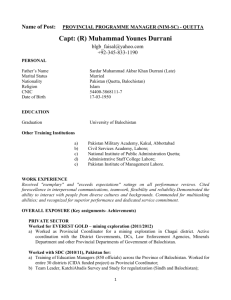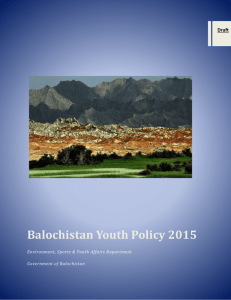RTE - Regional Conference on Right to Education & Early
advertisement
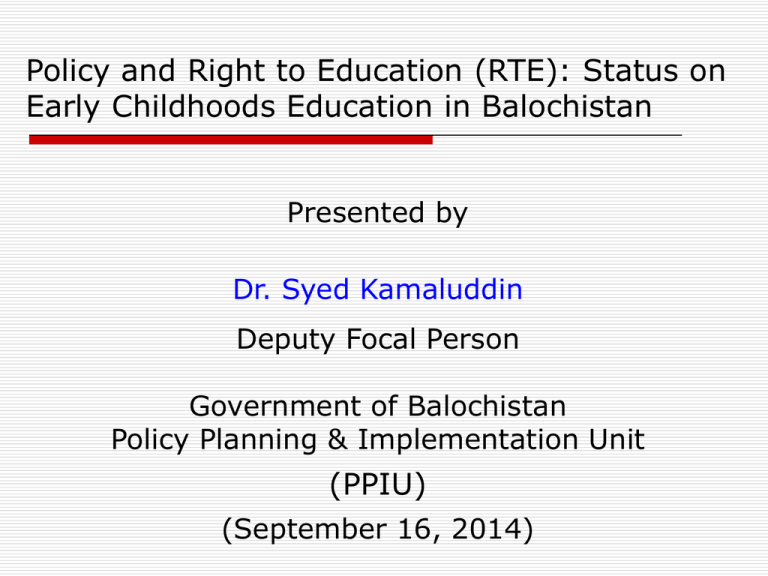
Policy and Right to Education (RTE): Status on Early Childhoods Education in Balochistan Presented by Dr. Syed Kamaluddin Deputy Focal Person Government of Balochistan Policy Planning & Implementation Unit (PPIU) (September 16, 2014) Overview Prelude ECE progress in Balochistan Performance assessment framework Targets set under BESPP ECE budget in PSDP Collaboration of donors Policy legislative & other reforms Way forward 2 Prelude Pakistan education system strands at a critical juncture with constitution decree of Article 25-A declaring education as fundamental right for children of 5-16 yrs of age. In addition to its own constitutions, Pakistan is also inevitable by international commitments and treaties. The UN convention on Rights to Child (CRC), which is most extensive international treaty on rights of children, commits states to ensuring the rights of all children on basis of equal opportunity The UN committee on CRC calls on states to recognize that children are active participants in decisions them and to pay special attention to the neglected area of early childhood. The Jomtien Declaration for EFA stated that learning starts at birth. The Dakar framework for action reaffirmed this and 180 world leaders signed up to EFA goals where goal 1 illustrates that” “Expanding and improving comprehensive early childhood care and education, especially for the most vulnerable disadvantaged children”. 3 Prelude In pursuance of the Dakar World Education Forum, the Government of Pakistan developed a National Plan of Action 2001-15. This plan aimed at development of education sector as a whole with a special focus on EFA goals with ECE as one of its three areas of focus; One of the salient features of National Education Policy 2009 stated that: “ECE shall be based on a concept of holistic development of the child; age group shall be recognized as comprising 3 to 5 years, at least one year pre-primary education shall be provided by the State; ECE shall be attached to primary schools provided with additional budget; teachers and assistants for this purpose; and, for ECE teachers, a two-year specialized training shall be a necessary requirement based on ECE revised National Curriculum” In order to introduce ECE, a national curriculum for ECE was developed in the year 2002 revised in 2007. The Higher Education Commission has developed curriculum for the elementary school teacher (ADE Programme) which also caters the professional needs of ECE teachers. Federal Ministry of Education has developed the Early learning and Development standards 4 ECE significance The criticality and advantages of ECE are now established from biological ,social, economic, cultural and human development standpoints. Study have demonstrated the efficacy ECE in improving access especially for the most disadvantage evidence from around the world suggest that the most disadvantaged children whether because of poverty, ethnicity, gender, rural isolation or disability, experience the most dramatic gains from ECE. The India village pre-school study, for example, found that the children who had participated in an ECE program were twice as likely to enroll in school as matched controls. In Nepal more than 95% of program children enrolled compared to an overall figure of less than 70%. The results are even more dramatic, with very little dropout amongst the children who have participated in a pre-school program. 5 ECE significance Significant reductions in school failure, repetition, absenteeism and dropout rates were found in the vast majority of the studies looking at the effects of ECE worldwide. The Mingat and Jaramillo studied impacts of Early Childhood Care and Education in Sub-Saharan Africa and found completion rates of 50% in the absence of pre-school and around 80% where half the children have access to pre-school or ECCD centers. In Peru, a recent study found that nearly 60% more poor children who participated in pre-school completed primary school as compared with poor children who didn’t access pre-school. (Reference: AKF report on ECE) 6 : Total number of schools & enrollment in Balochistan School Type No. of Public Schools Boys Girls 7807 2778 Middle 670 495 1165 High 550 233 783 26 17 43 9053 3523 Primary Higher Secondary Total Total Enrollment Boys Girls 10585 345144 205980 102079 87824 211242 117126 14608 20128 Total 551124 189903 328368 34736 12576 673073 431058 1104131 7 Performance assessment framework Indicators Initial 2013-14 2014-15 2015-16 2016-17 2017-18 Value 1. Access 1.1 ECE Currently, it is a Katchi class with limited concept of ECE, material and even classroom and teachers 51%no 51% 55% for this age group 59% 63% 67% 1.2 Primary 44% 47% 49% 51% 52% 54% 1.3 Middle 26% 27% 29% 30% 31% 32% 1.4 High 13% 14% 15% 16% 17% 18% 2.1 Primary 45% 46% 47% 48% 49% 50% 2.2 Middle 79% 80% 82% 83% 84% 85% 2.3 High 93% 93% 94% 94% 95% 95% 2.Survival Rate Performance assessment framework Indicators Initial Value 2013-14 2014-15 2015-16 2016-17 3. Intake Rate 3.1 Primary 60% 62% 64% 66% 68% 3.2 Middle 39% 40% 42% 43% 44% 3.3 Secondary 18% 20% 21% 22% 24% 9 Performance assessment framework Indicators 2013-14 2014-15 2015-16 2016-17 2017-18 4. Quality 4.1 Literacy/Language (in Urdu) Grade-3 6% 8% 11% 15% 20% Grade-4 14% 16% 19% 23% 28% Grade-5 49% 51% 54% 58% 63% Grade-6 72% 77% 81% 86% 72% Grade-3 4% 8% 11% 15% 50% Grade-4 11% 13% 16% 20% 25% Grade-5 29% 31% 34% 38% 43% Grade-6 62% 64% 67% 71% 76% Grade-3 4% 8% 11% 15% 50% Grade-4 10% 12% 15% 19% 24% Grade-5 39% 41% 44% 48% 53% Grade-6 62% 64% 67% 71% 76% 4.2 Literacy/Language (in Eng) 4.3 Numeracy/Mathematics Comparative student competencies (ASER 2013) Indicators Balochistan Punjab National Grade-3 6% 27% 16% Grade-4 14% 46% 29% Grade-5 49% 66% 50% Grade-3 4% 25% 15% Grade-4 11% 44% 28% Grade-5 29% 62% 43% Grade-3 4% 19% 12% Grade-4 10% 36% 25% Grade-5 39% 56% 43% Literacy (in Urdu) Literacy (in English) Numeracy 11 ECE progress in Balochistan Schools focused Number UNICEF 300 RCC Project by SCSPEB 100 Balochistan Education Project (SCSPEB and IDO) IDSP & Taraqee Foundation Total 105 55 560 Schools with ECE facilities only 5% 12 Targets set under Balochistan Education Sector Plan (BESP) Targets 1. Establishment of ECE Centers 2.Establishment of Primary School 3. Up-gradation of Primary Schools to Middle Level 4.Up-gradation of Middle Schools to Higher Secondary Target by 2018 2013-14 2014-15 2015-16 2016-17 2017-18 3600 720 720 720 720 720 4000 800 800 800 800 800 800 80 160 240 240 80 100 10 20 30 30 10 Balochistan budget 2014-15 Name of Scheme Target Estimated Cost (in million) 1. Establishment of ECE Centre 720 Rs.843.84 2. ECE Teacher Rs.18000/- per month 720 Rs.155.52 3. ECE material @Rs.30000/- per school 720 Rs.21.60 4. Up-gradation of Primary School into Middle 318 Rs.2544.00 5. Construction of Building already approved shelter less Primary School 1800 Rs.9000.00 170 Rs.1275.00 7. Providing General Toilet 2000 Rs.600.00 8. Additional Class rooms overcrowded schools 1000 Rs.1300.00 9. Construction of Building Primary School 1100 Rs.5500.00 340 Rs.2720.00 6. Up-gradation of Middle School into High 10. Up-gradation of Primary School into Middle 14 Collaboration of donors in Balochistan Development Partner Project Name Implementing Entity DFAT, Australia ECE/ECD Program Aga Khan Foundation Idara-e- Taleem –o-Aagahi (ITA) ECE Program UNESCO Supporting Provincial Capacity Building to Realize Girls’ Rights to Education ITA Geographic Scope Financial Commitment Year Area of support Gawadar, Killa Saifullah and Quetta AUD 4.75 million 2010-2015 Lesbella, Killa Saifullah & Quetta US$ 1.4 million 2014-2018 Access to Early Childhood Development Access for girls to ECE & P/S in 100 schools; support material Expanding access for girls to primary and secondary education through policy support; and improving quality Department of Across the Edu. province Balochistan (BEF) Malala Fund 2014-2016 15 Collaboration of donors in Balochistan Development Project Name Implementing Geographic Partner Entity Scope World Bank Balochistan Balochistan Province Education Education wide Support Foundation/Se Program condary Education Department World Bank Promoting PMU/ 12 districts Girls Secondary Education in Education Balochistan Department Global Balochistan PMU/ Province Partnership forEducation Secondary wide Education/ Project Education World Bank Department Financial Year Area of support Commitment USD 22 2006-2014 Increasing Million (loan) access through community and public private partnerships. UNICEF Promoting Girls Education in Balochistan Government of Balochistan, Secondary Education Department Upstream work: the whole province. USD 10 Million (grant) 2012-2015 Access/Commu nity partnerships USD 34 Million (grant) 2014-2017 Access, Quality, Community partnerships and Monitoring USD 15 Million (grant) 2013-2017 Access, Quality, Capacity Building and system strengthening 16 Proposed assessment methods on Early Childhood Education 1. Classroom Level Child Assessment 3. Health Growth Teachers Assessment Weight Classroom Environment Immunization Head Teachers Medical checkups 2. Parental Support Involvement Level of understanding Sharing of Child Development Reports • Health • Academic 4. System Diagnosis (through proposed Balochistan Examination & Assessment Commission- BEAC) 17 Policy, legislative & other reforms Declared ‘Education Emergency’ in the province Act (Article 25-A) on Free and Compulsory Education is promulgated Act on Introduction of Mother Language in early grades is promulgated Future teachers selection through National Testing Service (NTS) notified & MOU also signed with NTS Developed ECE policy framework in collaboration with AKF Planned continuous professional development (CPD) of teachers and head teachers at all levels Development of new textbooks aligned with national curriculum 2006 student learning outcomes (SLO’s) 18 Way forward Government of Balochistan Commitments to expand the ECE from 5% to all schools in phase wise manner The CPD and pre-Service trainings needs to be aligned with the concept of ECE Availability of teaching-learning resource material (TLR) especially for ECE and primary level to make the teaching-learning processes more attractive Construction design of the schools need to be reviewed and aligned with the needs of the child Approval and implementation of ECE policy frame work from Balochistan Cabinet 19 Thank you <kamalshahppiu@gmail.com>

